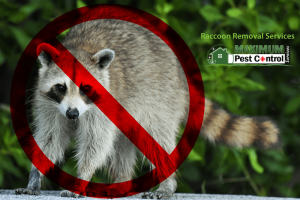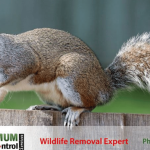
Do Motion Sensor Lights Deter Raccoons?
Raccoons may look cute and cuddly, but these clever mammals can be a real nuisance when they take up residence too close for comfort. Known for raiding trash cans, gardens, and even finding their way into attics or chimneys, getting rid of raccoons once they’ve settled in can prove challenging. One deterrent method homeowners sometimes try is installing motion sensor lights around the property.
The theory is that they avoid well-lit areas where they have no cover and could be easily seen by predators or humans. Motion lights overwhelming dark spaces with unexpected brightness startle the nocturnal creatures and convince them to move on. But do they really work effectively, or just provide a temporary fix before raccoons get used to them? Let’s examine both benefits and drawbacks of this type approach.
Raccoon Behaviour and Eating Habits
With their distinctive masked faces and ringed tails, are unmistakable guests – although their presence is rarely welcomed by homeowners. These resourceful mammals are remarkably intelligent and tenacious when it comes to procuring food and denning sites. Raccoons are nocturnal, while their natural diet consists of fruits, plants, insects, small mammals and eggs, are also opportunistic omnivores.
They will readily raid trash cans, compost piles, pet food bowls and vegetable gardens when such easy meals are available around residential areas. Raccoons lack a true hibernation period, so they remain constantly active and driven to seek out sustenance year-round. Their nimble front paws allow them to easily open containers, tear off siding or shingles, and access seemingly secure areas as they search for high-calorie meals.
What Risks Do Racooons Pose?
While raccoons may seem like mischievous but harmless creatures, they can actually pose several potential risks when they take up residence near human dwellings. Their constant rummaging for food brings them into confrontations with pets, where raccoons will fight viciously to defend themselves. They are also a prime vector for transmitting diseases and parasites like rabies, roundworm, and leptospirosis through their feces and fur.
They seeking shelter often make dens in attics, chimneys, or between floors and walls of homes and outbuildings. This not only creates a terrible mess from their wastes and food debris, but their gnawing and clawing habits can cause serious property damage over time. Homeowners may also be surprised by aggressive behavior from normally docile raccoons protecting a litter of young. Preventing and deterring raccoon activity around living spaces is advisable for health, safety and structural reasons.
The Significance of Motion Sensor Lights in Deterring Raccoons
Motion sensor lights are an effective deterrent against raccoons trying to raid your property. They avoid well-lit areas, as the bright light exposes them and ruins their stealthy efforts. A motion sensor suddenly illuminating an area they are trying to invade will startle and scare them away.
The lights need to be positioned to properly illuminate areas where try to access, like trash cans, gardens, sheds, etc. The sudden burst of brightness triggers a raccoon’s sense that they’ve lost concealment from potential predators. Most will quickly retreat rather than remaining in the spotlight.
Motion lights provide excellent raccoon deterrence at a low cost. The lights only activate when triggered by motion, so energy usage is minimal. They provide around-the-clock security against raccoons and other intruders without taxing your electricity bill.
Trained Wildlife Experts for Efficient Removal of Pest Animals
When dealing with pest animals around your home, relying on trained wildlife experts is crucial for safe and effective removal. These professionals have the knowledge and proper equipment to humanely trap, remove and relocate nuisance wildlife without harm to you, your property or the animals themselves. Attempting removal on your own can be extremely dangerous.
Trained wildlife control experts know the habits and behaviours of different animal species. This allows them to strategically set up humane traps and properly handle each situation. They also understand animals’ potential to carry diseases like rabies. Experts take proper precautions and follow regulations to protect you.
In Summary
- Motion sensor lights startle raccoons with sudden brightness and movement
- However, these animals are clever and quickly adapt to the lights
- Lights alone won’t stop determined raccoons from raiding garbage cans
- Combining lights with other deterrents like ammonia-soaked rags is more effective
- Solar-powered motion lights are an Eco-friendly, low-cost deterrent option
- But lights should be just one part of an integrated pest control approach
- Physical barriers, humane animal removal and removing food sources remain the best raccoon defenses
- Still, motion lights can help scare them away in the short term
The Benefits of Professional Wildlife Removal Services
Dealing with wildlife invasions requires expertise. Professional wildlife removal services ensure safety for humans and animals. These specialized services offer valuable benefits.
One key advantage is their skill in wildlife exclusion. They implement effective exclusion measures to prevent future infestations. This includes sealing entry points like gaps in roofs, walls, foundations. They install protective barriers, fences, identify and address potential access points.
When wildlife enters residential areas, it threatens homeowners’ safety and property. Removal experts handle these situations using humane techniques. They safely remove wildlife from homes. Services include evaluating and removing nests or dens, effective trapping and relocation methods.
Commercial properties like businesses and industrial sites also need wildlife management for a safe environment. Removal services provide comprehensive commercial solutions tailored to each business’s needs. They offer regular inspections, monitoring, customized wildlife plans, response to emergencies.
Relying on professional wildlife removal avoids dangers of amateur handling. Their techniques are proven, ethical and ensure lasting resolution. Whether residential or commercial, these experts provide peace of mind.
Conclusion
Deterring raccoons humanely takes some strategic efforts. Motion sensor lights can help, though they’re no magic solution. These clever critters quickly get used to the lights and ignore them. For reliable raccoon control, call pros who prioritize humane wildlife removal.
The best raccoon deterrents create unpleasant but harmless multi-sensory experiences. Pair bright lights with loud sounds and smells raccoons dislike. Popular options include flashing LED deterrent lights, high-frequency noise makers, and ammonia-soaked rags near entry points. An integrated approach works better than sensor lights alone.
When raccoons prove persistent, don’t trap them yourself. Hire an experienced wildlife management company. Maximum Pest Control will safely remove them using proper techniques and exclusion devices. Humane wildlife control focuses on changing raccoon behavior through deterrents and habitat modification rather than harmful tactics.





